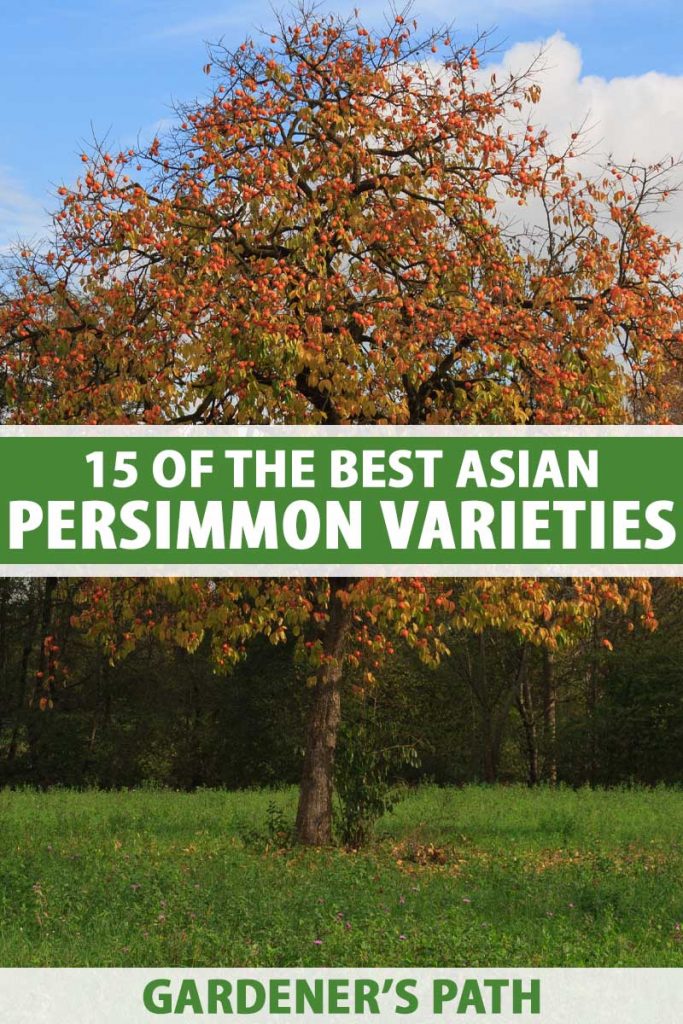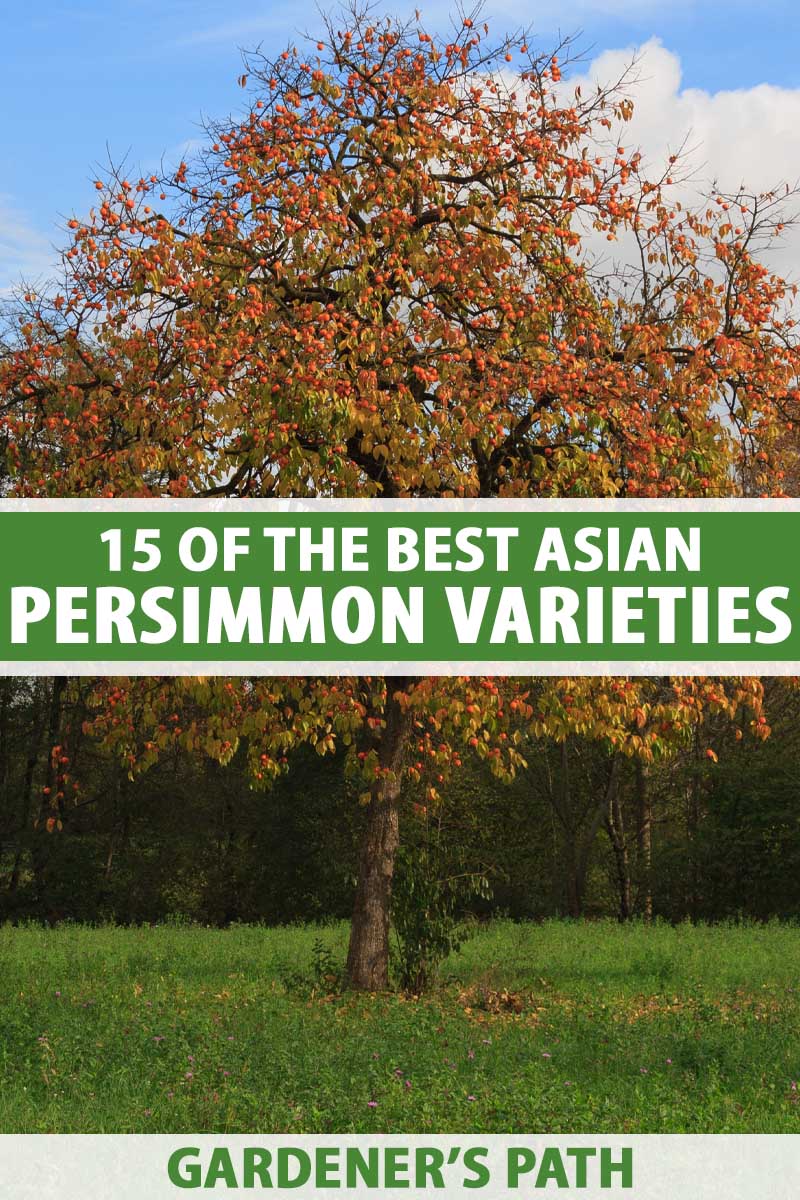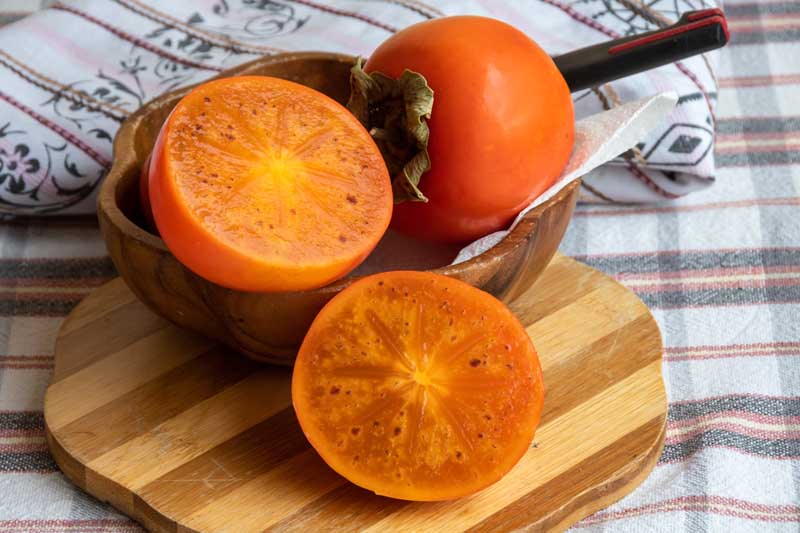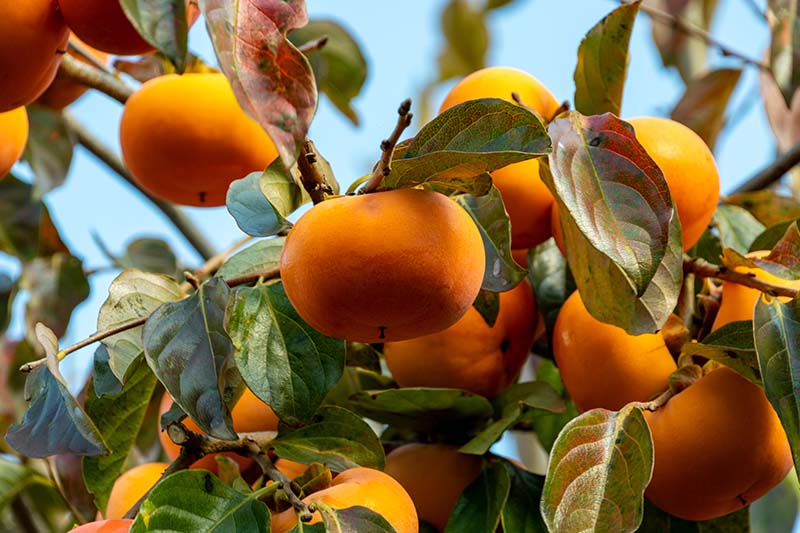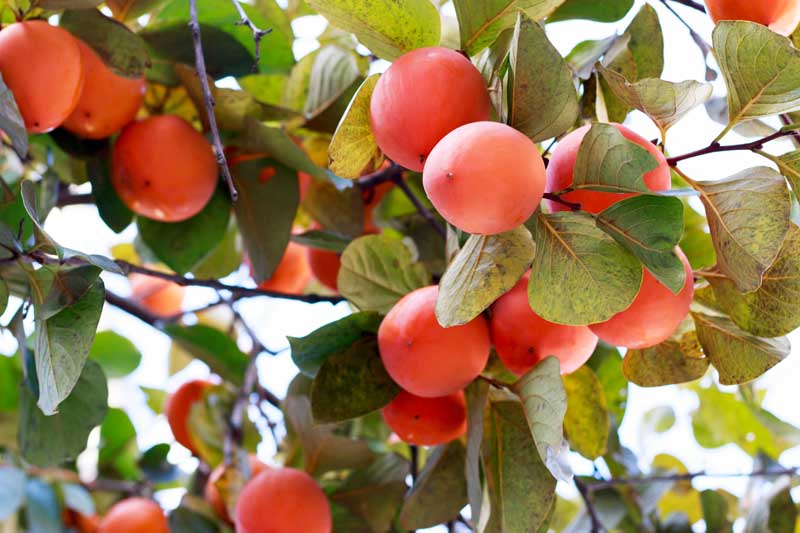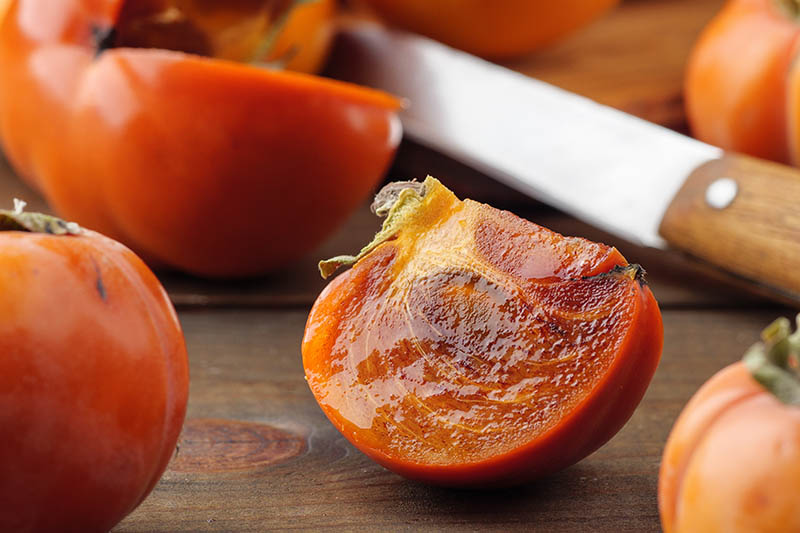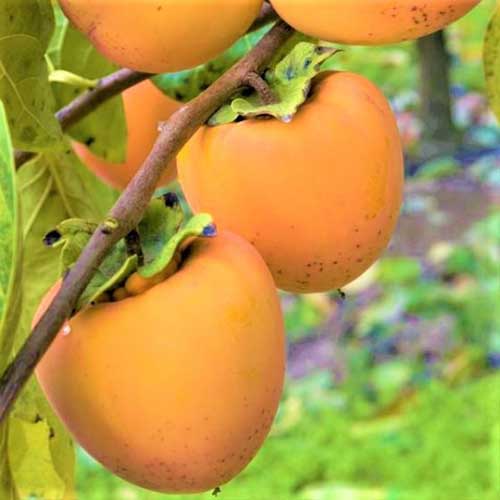Perhaps you once bit into an underripe fruit and it conjures up a memory of that tingly, cottony feeling you get on your tongue when you’ve eaten something full of tannins. Or maybe you think of the wild trees growing across the southeastern United States, and the wildlife that lines up to nibble the fruits as they fall to the ground. We link to vendors to help you find relevant products. If you buy from one of our links, we may earn a commission. Persimmons offer these qualities and more, and they come in a range of sizes, shapes, colors, flavors, and textures.
The trees can range from tiny to towering, and the flesh of the fruit can have a texture ranging from crisp and jicama-like to jiggly like a bowl full of jello. So, how do you decide which types are right for you to grow in your garden? We’re here to help with that. To begin, there are two categories of persimmon: astringent and non-astringent. You’ll sometimes see all astringent fruits generalized ‘Hachiya’ and all non-astringent fruits as ‘Fuyu.’
Astringent varieties don’t become sweet until they’re fully ripe, while non-astringent types are sweet even while still firm and not quite ripe. There is a second classification that relates to pollination. These classifications are known as pollination-constant and pollination-variant. Pollination-constant varieties produce fruits with the same color and consistency regardless of whether they are pollinated or not. Pollination-variant types typically produce fruit with light colored flesh when they are not pollinated (and seedless), and brown colored flesh as a result of pollination. Collectively, the fruits are grouped as pollination-constant astringent (PCA), pollination-constant non-astringent (PCNA), pollination-variant astringent (PVA), pollination-variant non-astringent (PVCA).
There are two different types of persimmons commonly found in the US: Diospyros kaki, the Asian species, and D. virginiana, the “common” or American persimmon. In this roundup, we will focus on our favorite cultivars of D. kaki that are perfect for growing at home. Note that all D. kaki cultivars can handle temperatures down to 10°F and all require about 100 hours of temperatures below 45°F to blossom and fruit. However, some can handle colder temps, and a few don’t need any chill hours. Those are noted below.
Also be aware that unlike many fruit trees, most Asian persimmons you’ll find at nurseries don’t need a companion to grow fruit. Thousands of cultivars have been developed to date in China and Japan, some of which were brought into the US in the early 1900s. In the US, far fewer named cultivars are available to home growers. Here, we’ll share 15 of our top picks that we think you will enjoy.
1. Chocolate
‘Chocolate’ gets its name because on the outside, it looks like your average persimmon, with bright orange flesh. But when you take a bite, the flesh is brown like chocolate jelly, as if a magician had transformed it into a cocoa-based confection. Sadly, it doesn’t taste like chocolate. But this “fruit of the gods” is almost as good. It’s sweet with a bit of nutty spice, and incredibly juicy. Even before you take your first bite, it’s clear that this variety is special. The medium-sized fruit has bright red skin that looks stunning in a bowl on your table. Even better, the fruit is seedless.
‘Chocolate’ This pollination-variant astringent type is one of the last varieties to ripen, ready for harvest in late October through mid-November. You can find five- to six- and six- to seven-foot tall trees available at FastGrowingTrees.com.
2. Eureka
Eureka! We’ve struck gold with this persimmon! At least, that’s what I imagine the breeder shouted after tasting the fruit of this particular variety. ‘Eureka’ is a pollination-constant astringent cultivar that is popular across the US and Asia. The fruits are medium in size and are ready to pluck from late October through early November. The skin is a pleasing red color. But the top reason why this type is one of the more common varieties is because of the texture that holds well even as it sits on the shelf. Many Asian persimmons are seedless, but this particular variety has seeds.
3. Fuyu
‘Fuyu’ is one of the most widely-grown non-astringent cultivars in the world, and there’s a good reason for that. This tree has a lot going for it. The fruit doesn’t have a core or seeds, and the pumpkin orange skin matches the interior. The squat fruit is topped with a tiny green cap that isn’t as large as some other varieties, which makes it just about picture-perfect for a fall display.
‘Fuyu’ As it’s non-astringent, so you can bite into the medium to large fruits straight off the tree, even when they are still firm. They have a luscious texture that varies from crisp and apple-like when it’s young and softens as it ages. The flavor is more sweet and rich, with a hint of clove, as it further ripens. One of the great things about this type is that the fruits rarely have imperfections, so if you’re selling these at the farmers market, you’re likely to get a high rate of sellable fruits. ‘Fuyu’ is ready for harvest later in the year. Picking time typically arrives from the middle of November to the middle of December. You can find a sapling in a one-gallon container from FastGrowingTrees.com.
4. Giombo
Another pollination-variant astringent variety, ‘Giombo’ produces massive fruits with a slightly conical shape. Unlike some others, this type bears fruit every other year when it’s young. After it matures, it bears fruit annually. When it’s ripe, the skin is a pretty, almost translucent orange, wrapped around jelly-like flesh. What sets it apart, though, is its flavor. It has a spicy-yet-sweet taste that only improves the more ripe it gets. ‘Giombo’ is ready for harvest from mid-September to mid-October. Watch out, though. It can leaf out early, making it susceptible to late frosts. If you do have a late frost, cover the tree with a tarp or blanket to protect it. Remove the covering when temperatures are above 34°F.
5. Great Wall
This pollination-constant cultivar got its name when plant geographer J. Russell Smith spotted one growing near the Great Wall of China in the 1920s and brought it back to the US. Since then, some growers have grafted it on to American persimmon rootstock to make it more tolerant of colder temps. An astringent type that stays within a compact 20 feet tall, the flesh of ‘Great Wall’ turns a cinnamon-orange shade when the fruit is ripe. The skin is medium orange. This one ripens in late September through late October.
6. Hachiya
‘Hachiya’ produces pretty fruit, with an acorn-like shape wrapped in a bright orange skin. It’s one of the most popular types and is widely grown in California. Inside, the flesh can be incredibly astringent, so you need to let this one ripen significantly before you’ll get a good flavor out of it. Given time, the overripe fruit is even sweeter than non-astringent types like ‘Fuyu.’
‘Hachiya’ A pollination-constant type, you can start plucking ripe fruits off the tree in mid-November and the harvest may continue through mid-December. Pick up a tree for your garden at Nature Hills Nursery.
7. Izu
This is another popular type, perhaps because it’s one of the earliest to ripen. Once it’s mature, you can expect to be plucking fruits off the tree by mid-September, and harvests may last through mid-November. The fruits are medium to large in size. A pollination-constant non-astringent variety, ‘Izu’ has a compact growth habit and the fruit is very sweet. Young trees are a bit slow to start growing, but once established, they are reliable performers.
8. Jiro
‘Jiro’ is another popular type, but the drawback here is that when the tree is young, yields are unpredictable and erratic. Once the tree matures, harvests are more consistent. The fruit is medium to large, ready to harvest from mid-October through mid-November. Watch out for tip cracking. This cultivar is prone to splitting at the end if it experiences strong, lashing wind or extreme heat. You can’t prevent it, so if you see fruits cracking, pluck and use them right away if they are ripe enough. ‘Jiro’ is a pollination-constant non-astringent variety. It’s more cold-hardy than most Asian persimmons and can handle temperatures down to 0°F.
9. Maekawa Jiro
You might have guessed from the name, but ‘Maekawa Jiro’ is a bud sport of ‘Jiro.’ While the tree isn’t very vigorous, the fruit is large. However, these fruits are prone to tip cracking, as well. Harvesting time is from late October through late November. Non-astringent and pollination-constant, ‘Maekawa Jiro’ lacks the spicy notes of other persimmons, with a flavor like sugar cane. The trees stay compact at under 15 feet tall, which makes harvesting a breeze. Like it’s parent ‘Jiro,’ the tree can grow in temperatures down to 0°F.
10. Midia
While ‘Midia’ fruit are extremely large for a non-astringent pollination-constant variety, up to 12 ounces each at maturity (0.75 pounds), the trees aren’t particularly vigorous. On top of that, you may need to thin the fruits to achieve a good harvest, a practice that isn’t required for most Asian types besides ‘Fuyu.’ Don’t let that scare you off. The incredibly flavorful fruits have beautiful orange skin and an indented ring that makes them stand out. You can expect to harvest fruits from late October to late November.
11. Saijo
If you love the taste of honey, ‘Saijo’ is the persimmon for you. The flesh is intensely sweet and juicy, and seedless or nearly so. The flesh of this astringent pollination-constant variety is medium orange and the fruit has a conical shape.
Like ‘Tanenashi,’ below, this is a good choice if you want to dry your persimmon. Otherwise, wait until it gets soft, like a ripe tomato, before digging in. You should be able to start gorging yourself (am I the only one who does this during persimmon season?) in mid-September through mid-October.
12. Sheng
This cultivar has distinctly gelatinous, medium to large fruit that’s ready to pluck from mid-September to mid-October. I think the fruits are particularly cute because they’re quite squat, sort of like tomatoes that someone (gently) sat on. When ripe, this pollination-constant astringent type is incredibly sweet, with a nutty flavor that sets it apart.
13. Suruga
‘Suruga’ produces incredibly sweet medium-to-large fruits. The pollination-constant non-astringent fruits are incredibly sweet and spicy, and they hold their flavor off the tree for a long time. This type is typically ready to harvest from October through November.
14. Tanenashi
‘Tanenashi’ is a pollination-constant astringent cultivar with light orange to red skin and yellow-orange flesh. This cone-shaped fruit is a popular variety for drying in Japan. Fresh and fully ripe, it has a sweet and rich flavor, and the fruit typically ripens from September to October.
15. Triumph
You can hardly blame plant growers for choosing a name like ‘Triumph’ when they create a cultivar that really stands out. This cultivar is notable because it doesn’t need a period of chill hours below 45°F to bloom, unlike some persimmons. A pollination-constant astringent variety, ‘Triumph’ produces small, squarish fruit, which is extremely juicy with few or no seeds. It also has a lengthy harvest time, from September through November. It has firm skin, unlike some other varieties, even when it is ripe. That makes storing and handling easier. This variety is commonly grown in Israel, where it is often called “Sharon fruit.”
Persimmon Perfection
While some people still might not be able to recognize a persimmon when they spot one at the grocery store or farmers market, or they have no idea what to do with it after they bring it home, it’s clear that this delicious delicacy is getting the attention it deserves in some circles. With more and more cultivars available in the US, it’s easier than ever to grow your own at home.
Whether you’re an old hand at growing persimmons or you’re a new grower looking for a few options to add to your orchard, you can’t go wrong with picking one of the beauties described above. I can’t wait to hear about which cultivar you end up going with and what you think of the tasty fruit. Be sure to come back and tell me all about it (and don’t forget to share a few recipes)! And for more information about growing persimmons in your garden, check out these guides next:
How to Grow Asian Persimmon Trees When and How to Harvest Persimmons How to Grow American Persimmons
© Ask the Experts, LLC. ALL RIGHTS RESERVED. See our TOS for more details. Product photos via FastGrowingTrees.com and Nature Hills Nursery. Uncredited photos: Shutterstock. With additional writing and editing by Allison Sidhu and Clare Groom.
